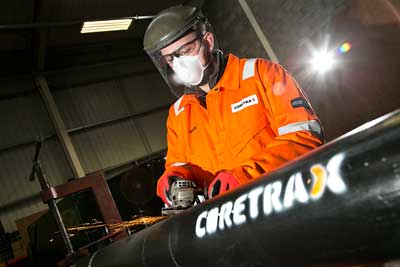Coretrax, a leading engineered servicing company for wellbore clean and abandonment, has secured cost savings of nearly £10million in rig time for UK operators.
Focused on improving operational efficiencies and saving rig time in wellbore clean up and abandonment operations, Coretrax’s range of CX-products have been used extensively in decommissioning contracts with operators since 2012.
A Coretrax technician working at the company’s Aberdeen HQ. Credit: Coretrax
One solution from the product range used was the CX-2 bridge plug which is a versatile tool, suited to multiple applications in the oilfield, which reduces cement disturbance and rig time. In addition to this Coretrax have delivered time savings through drill pipe cleaning tools and by combining CX-2 bridge plugs with disposable scrapers to save trip time.
Earlier this year, Coretrax completed the setting of its 150th bridge plug as part of an ongoing abandonment campaign for an operator project in the UK sector. Approximately 40 bridge plugs have been run for the campaign to date, along with swarf recovery strings and drillpipe cleaning tools, and a 100% success rate achieved.
Coretrax global business development director, John Fraser said: “We’re proud that our innovative approach to well abandonment has saved operators almost £10million in rig time since 2012. In the current industry climate, cost savings are imperative and the fact that our technologies significantly contribute towards this is a key benefit for our customers worldwide.
“The design and versatility of the CX-products provide a sound solution for cementing operations. Achieving these cost savings as well as the setting of our 150th bridge plug are fantastic milestones, which not only highlights the reliability and effectiveness of the tool but further underpins our position as one of the leading suppliers of bridge plugs in the North Sea.”
Coretrax was established in 2008 to provide specialist wellbore clean up and wellbore abandonment tools, offering a wide range of downhole tools and services which provide up-to-date solutions to improve time efficiency, maximise cost reduction, reliability, damage prevention and technological advancement to the global oil and gas industry.
The company currently employs 42 people across its bases in Saudi Arabia, Abu Dhabi, Dubai, Kuwait and Aberdeen.


 As an indicator of the turmoil that has hit the US oil & gas services sector the Baker Hughes rig count is hard to beat. From 1,931 rigs drilling in September 2014 the count has declined to a total of 408, dramatically reducing activity and jobs for drillers, service companies and suppliers alike.
As an indicator of the turmoil that has hit the US oil & gas services sector the Baker Hughes rig count is hard to beat. From 1,931 rigs drilling in September 2014 the count has declined to a total of 408, dramatically reducing activity and jobs for drillers, service companies and suppliers alike.
 Autonomous underwater vehicles (AUVs) have been in operation for a number of years and are an established part of underwater activity, particularly in research and military where they are utilized for activities such as mine clearance, hydrography and data collection. Despite widespread use, there is still potential for substantial growth – each new technological advance increases the viability of the vessels in different sectors. This is particularly clear in oil & gas, where AUVs remain niche assets.
Autonomous underwater vehicles (AUVs) have been in operation for a number of years and are an established part of underwater activity, particularly in research and military where they are utilized for activities such as mine clearance, hydrography and data collection. Despite widespread use, there is still potential for substantial growth – each new technological advance increases the viability of the vessels in different sectors. This is particularly clear in oil & gas, where AUVs remain niche assets.